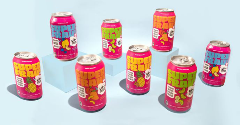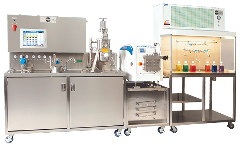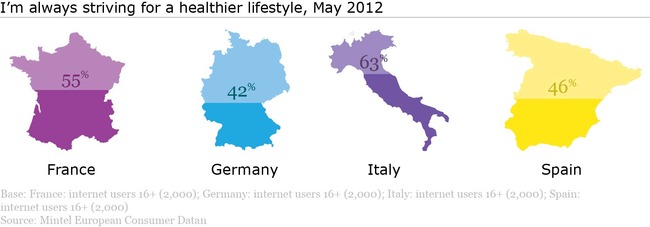European Juice-Makers Offer Vegetable Innovation
5 Jun 2012The Mintel Inspire trend A Simple Balance for Health maintains that “simple, uncomplicated habits are always a good option. Sticking with the basics is a surefire way for brands to score with health-seeking consumers.” In the juice segment, vegetable blends are one example of a back-to-basics approach. They balance out the need for both fruit and vegetables, […]

The Mintel Inspire trend A Simple Balance for Health maintains that “simple, uncomplicated habits are always a good option. Sticking with the basics is a surefire way for brands to score with health-seeking consumers.”
In the juice segment, vegetable blends are one example of a back-to-basics approach. They balance out the need for both fruit and vegetables, and as consumers a growing number of countries face obesity issues, vegetables’ lower sugar and calorie levels offer an option for keeping those factors in check.
In Europe, vegetable juice introductions are back on the rise after dropping considerably for several years. Juices that use vegetable as a flavor component (which excludes products that contain vegetable juice and extracts only for natural color) fell by more than half between 2007 and 2010. But they began climbing again last year, and this year have already seen nearly as many introductions as all of last year.
Spain, Italy, Belgium and the Czech Republic all have increased their share of Europe’s vegetable juice introductions during the past two years. Germany has retained its position at the top of the list, although its share of overall introductions in the region dropped slightly.
Consumers in Europe report that they are trying to live healthier. In fact, more than half (55%) of consumers in France and a nearly two-thirds of those in Italy say they are always striving for a healthier lifestyle. Those percentages are slightly lower for Germany and Spain (42% and 46%, respectively), but still significant. That seems to offer a chance for juice to promote vegetable content as well as fruit for a wider range of nutrients.
While a number of the new European vegetable juice rollouts are veg-only, fruit and vegetable blends continue to become more popular. So far this year, fruit, citrus fruit and berry blends have accounted for 63% of introductions.
Carrot is the go-to vegetable for blends, accounting for 46% of the products introduced in Europe so far this year. That’s followed by tomato, which can be found in 26% of introductions in 2012. Beetroot accounts 9% of introductions so far this year, building on the vegetable’s growing reputation for lowering blood pressure, increasing stamina and athletic performance, and fighting inflammation.
Like consumers in most regions, European consumers report that they find it difficult to get the recommended five servings of fruits and vegetables a day. Interestingly, at 61%, consumers in Germany are among the most likely to say they struggle to meet their five-a-day. That means despite the number of vegetable-based juices on the market, consumers are not seeing them as part of their consumption goals. Juice-makers seem to be missing the opportunity to tie their vegetable juice products to these goals.part of their consumption goals.
Consumers across Europe report swapping out less-healthful snacks for fruits and vegetables, but some still prefer their veg to be blended in with something else rather than consumed straight up. Not surprisingly, younger consumers are most likely to say they prefer vegetables blended into smoothies or soup. In Italy, 29% of those under age 25 prefer consume vegetables this way, as do 28% of under-25s in Spain and 21% in Germany. That leaves potential for juice-makers that can appeal to these younger consumers by blending the vegetables they know they should be eating into a more preferred format.
As consumers become more comfortable and familiar with vegetable-based juices, drink-makers can look to the East for new concepts. Japan and China are the two leading vegetable juice innovators globally, with Japan accounting for 13% of global introductions so far this year and China 9%.
Related news

Asian beverage brands deal with rising costs
4 Jan 2023
Decreasing bottle sizes or increasing prices? Asian beverage brands are finding “creative approaches” to manage rising costs, according to industry analysts.
Read more
Value-seeking US consumers cut back on food spending
2 Jan 2023
Cheaper items, smaller sizes, and shorter grocery lists: inflationary effects coupled with a global long-term recession are set to continue shaping food spending habits, according to a recent Rabobank report.
Read more
Opportunities grow for lower-caffeine coffee
23 Dec 2022
Many consumers want the mental focus of caffeine without the jitters, prompting a wave of product development such as “half caffeine” ground coffee or ready-to-drink (RTD) cold brew blended with relaxing botanicals.
Read more
Superfrau upcycles liquid whey for energy drinks
22 Dec 2022
US company Superfrau turns surplus whey into sustainable, upcycled-certified dairy products for the recovery drinks market.
Read more
Swedish food agency: One in 10 coffee brands contain excess acrylamide
7 Dec 2022
New findings from the Swedish Food Agency have revealed three of 29 coffee products sampled contained acrylamide above limits, reinforcing the link between levels and degree of roasting.
Read more
Editor’s choice: Our roundup of the latest women’s health products around the world
2 Dec 2022
From botanicals to combat menopause symptoms to a hydration powder for mothers-to-be, here is our roundup of the most innovative new product launches within women’s health.
Read more
The prize no brand wants to win: 2022’s most misleading products
28 Nov 2022
Food industry watchdog Foodwatch is asking consumers to vote for 2022’s most misleading product. A high-sugar vitamin water and “artisan” salad made with artificial additives are among the nominees.
Read more
enduracarb®: A science-backed trehalose ingredient for athletic endurance
24 Nov 2022
enduracarb® is a science-backed, slow-acting carbohydrate that can power athletes’ performance. Produced using a high-purity production process, it is suitable for a wide variety of applications.
Read more
China bans celebrity endorsement of health and formula foods
22 Nov 2022
China is to ban celebrity endorsement or advertising of certain products, completely banning high profile figures with “lapsed morals” as the country attempts to drive society towards “core socialist values”.
Read more
MicroThermics’ Formulators Guide to Process Selection for Plant-Based Beverages
15 Nov 2022
Plant-based beverages & products are mainstream! Come to FIE booth 4D122 & read our whitepaper to see how processing in the lab at commercial HTST & UHT conditions gets you to market faster for less!
Read more